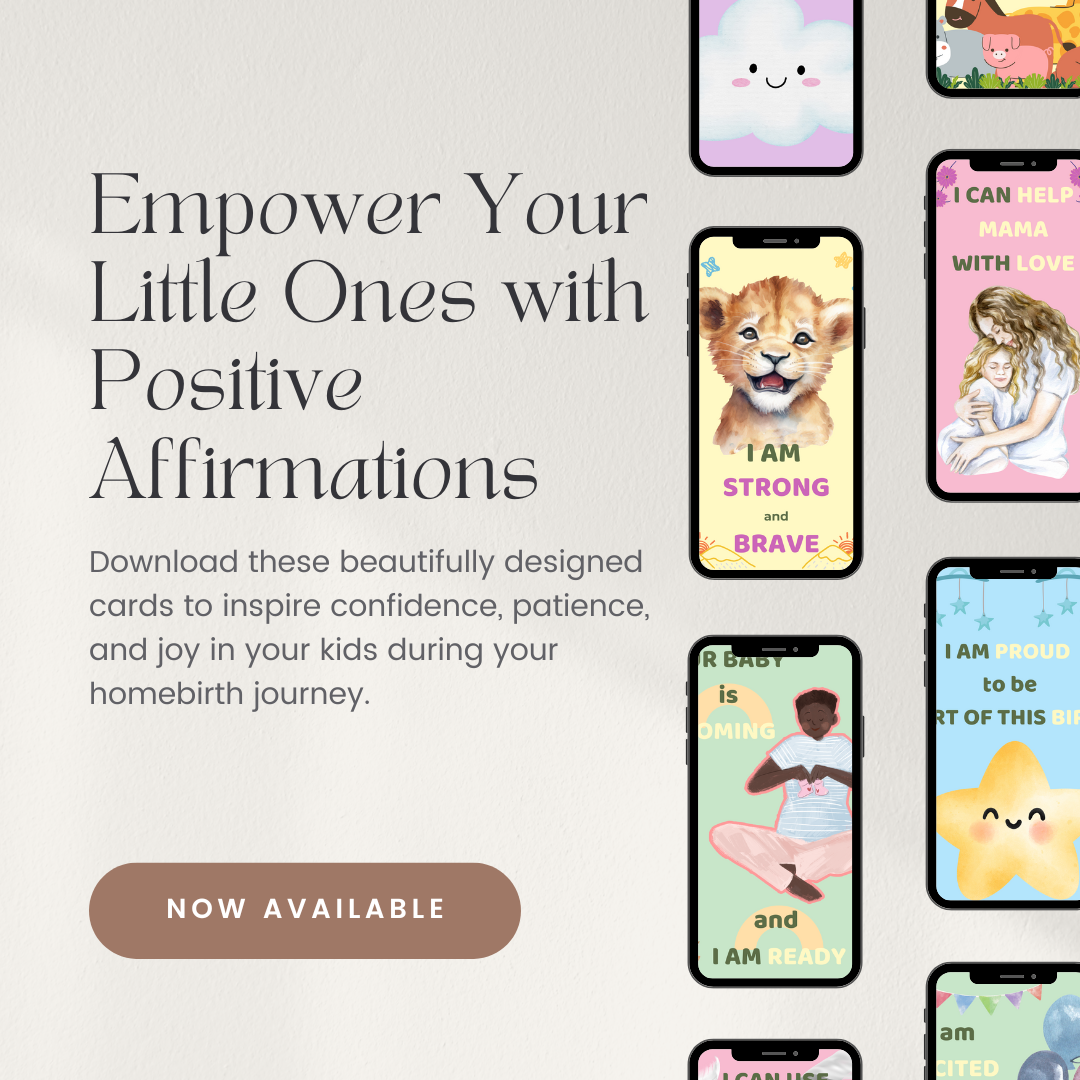
Best 9 Books to Prepare Siblings for Homebirth
Table of Contents
Introduction
Preparing siblings for a homebirth is such a beautiful and transformative part of the journey. Whether this is your first homebirth or you’re welcoming another baby, including your children in the process can help them feel excited, confident, and connected. I vividly remember how my older kids played such an important role during my homebirths—being curious, helping out, and most importantly, understanding what was happening thanks to the stories and books we read together beforehand.
Books were an incredible tool for us. They made the concept of homebirth feel natural, special, and even magical through age-appropriate language and illustrations. They also answered many of the questions my kids had—sometimes even before they asked them!
In this post, I’ve curated a list of the best books to help siblings prepare for a homebirth. These books explain the process in a simple and empowering way, help ease fears, and build excitement about welcoming a new baby into the family. Along the way, I’ll also share interactive activities and resources, including some of my own homebirth-related blog posts, to make the experience even more meaningful. Whether your children are toddlers or older kids, there’s a book on this list that will resonate with them and help you create a joyful and inclusive birth experience.
Let’s get started!
Why Prepare Siblings for Homebirth?
Preparing siblings for a homebirth can make the entire experience smoother, more positive, and deeply meaningful for the whole family. Children are naturally curious and often have many questions about where babies come from, what birth looks like, and what will happen at home. Books and open conversations can help address their questions in an age-appropriate, reassuring way.
Benefits of Involving Kids in the Homebirth Process:
- Reduces Fear and Anxiety: By explaining what to expect during labor, kids are less likely to feel scared or overwhelmed during the birth.
- Builds Excitement: Instead of feeling left out, children can look forward to their important role in welcoming the new baby.
- Strengthens Family Connection: Homebirth becomes a shared family experience, helping siblings feel included, proud, and connected to the process.
In our family, we didn’t shy away from talking about everything, including the placenta. I explained its incredible role in keeping the baby alive and growing during pregnancy, and I prepared my boys by letting them know it might look a bit bloody or “messy”—and that it’s completely okay. By normalizing it ahead of time, they weren’t scared at all when the time came. Instead, they were fascinated by the placenta, and one of my sons even cut the umbilical cord, which was such a special and empowering moment for all of us.
When I prepared my own kids for homebirth, I noticed how reading stories about other families’ birth experiences helped normalize it for them. They understood that birth wasn’t something to fear but something natural, loving, and special.
What to Look for in Books About Homebirth for Kids
When choosing books to help prepare siblings for a homebirth, it’s important to pick ones that are both engaging and age-appropriate. The right books can help children visualize the process, understand their role, and feel confident and excited about the upcoming birth. Here are some key elements to look for:
1. Simple, Age-Appropriate Language
- Books should explain the birth process in clear, child-friendly terms. For younger kids, focus on simple explanations and gentle imagery. For older children, books with more detail can help answer their questions about labor, midwives, and what to expect.
2. Engaging Illustrations
- Look for books with bright, beautiful illustrations or photographs. Visuals help kids connect with the story and understand what’s happening in a homebirth. Drawings of birth pools, midwives, and families together make the experience feel familiar and exciting.
3. Focus on Natural Birth and Family Involvement
- Choose books that celebrate natural homebirth in a positive, reassuring way. Stories showing siblings, midwives, and birth pools help normalize the process and make kids feel included.
4. Emotional and Educational Elements
- The best books combine emotional connection with practical information, helping kids understand the birth’s beauty while easing any fears they might have. Bonus points for books that mention the placenta, cutting the cord, or other fascinating parts of the birth process.
By choosing books with these elements, you can ensure your children feel prepared, excited, and ready to be a part of the big day.
H2: Top Books to Prepare Siblings for a Homebirth
Here’s a curated list of the best books to help children understand and feel excited about your homebirth. Each title has been chosen for its ability to engage young readers, explain birth in a natural and empowering way, and celebrate the special role siblings play during this incredible family event.
1. “Welcome with Love” by Jenni Overend
This beautifully illustrated story is told from a child’s perspective, capturing the excitement and wonder of a family homebirth. The book follows a family as they prepare for and welcome a new baby into their home, making it a relatable and reassuring read for children.
Why It’s Great:
It presents birth as a normal, loving event while emphasizing the role of family in the process. The gentle illustrations create a warm and calming vibe for young readers.
Key Takeaway: Birth is a natural, loving family event that kids can embrace with curiosity and joy.
2. “We’re Having a Homebirth” by Kelly Mochel
This straightforward, child-friendly book introduces kids to the concept of homebirth in simple, positive terms. It explains what to expect, what mom might need, and how siblings can help out during the birth.
Why It’s Great:
The book normalizes homebirth by showing it as a safe and exciting event, helping younger children feel more confident about the process.
Key Takeaway: Encourages kids to see homebirth as safe, normal, and exciting while making them feel included in the experience.
3. “Mama Midwife: A Birth Adventure” by Christy Tyner
This engaging story introduces children to the role of midwives in homebirth, blending education with storytelling. Through the eyes of a curious child, it explains how midwives support mothers during labor and delivery.
Why It’s Great:
It helps kids understand that midwives are friendly, knowledgeable helpers, making them feel reassured about the team supporting mom during birth.
Key Takeaway: It helps kids understand who midwives are and why they’re an important part of the birth process.
4. “Hello Baby” by Jenni Overend
This gentle, heartfelt book describes a natural homebirth experience from a child’s perspective, focusing on the joy and wonder of welcoming a new sibling. It’s perfect for helping children feel excited about their own family’s upcoming homebirth.
Why It’s Great:
The focus on family and the natural process of birth helps normalize the experience for children, while the simple narrative is easy for kids to connect with.
Key Takeaway: Celebrates the beauty of homebirth through a child’s eyes, fostering excitement and understanding.
5. “What Makes a Baby” by Cory Silverberg
This inclusive, straightforward book explains where babies come from in a way that’s perfect for kids of all ages. It introduces the idea of birth while leaving space for parents to provide more specific details about their unique family journey.
Why It’s Great:
The inclusive language and illustrations make this book adaptable for any family while gently introducing kids to the birth process.
Key Takeaway: Answers questions about the birth process in a way that works for all families, making it a great conversation starter.
6. “Our Water Baby” by Amy MacLean
This sweet book focuses on waterbirth, explaining how a birth pool is used during labor and delivery. It’s perfect for children who may be curious about the role of water in homebirth.
Why It’s Great:
It helps kids visualize what a waterbirth might look like and explains why some families choose it as part of their homebirth experience.
Key Takeaway: Helps children understand waterbirth in a calm and positive way, reducing curiosity or worry about the pool’s role.
7. “The Homebirth of a Baby Star” by Starhawk
Using poetic language and vivid metaphors, this story transforms the birth process into a magical, awe-inspiring event. It’s a great choice for kids who enjoy imaginative stories filled with wonder.
Why It’s Great:
The metaphors and imagery make it a unique and enchanting way to explain birth, perfect for families wanting to add a touch of magic to their homebirth preparation.
Key Takeaway: Encourages kids to see birth as a wondrous and natural process filled with beauty and love.
8. “My Mother is the Strongest” by Dr. Heather Manley
This empowering book celebrates the strength and resilience of mothers, showing children how capable and courageous their mom is during birth. It’s a wonderful way to instil pride and admiration for mom’s role in bringing a new baby into the world.
Why It’s Great:
It emphasizes the incredible strength of mothers, helping kids feel inspired and reassured about the process of labor and birth.
Key Takeaway: Reinforces a positive and awe-inspiring image of motherhood, helping siblings see birth as a powerful and loving event.
9. “Welcome Home” by Alisha Bourke
It is a heartfelt book that walks children through the experience of welcoming a new sibling into the family after a homebirth. It provides simple, engaging explanations about what happens during and after the birth.
Why It’s Great:
The book focuses on the bond between siblings and the joy of becoming a big brother or sister, making it relatable for kids of all ages.
Key Takeaway: Celebrates the family connection created through homebirth and helps kids feel excited about their new role.
Interactive Activities Inspired by the Books
Reading books about homebirth is just the beginning of preparing siblings for the big day. Interactive activities can take their learning to the next level by engaging their imagination and helping them feel truly involved in the process. Here are some creative and meaningful ideas to make the experience even more special:
1. Create Birth-Themed Art
- Encourage your kids to draw or paint what they imagine the homebirth will look like. They could create pictures of the birth pool, the new baby, or the whole family.
- Collect natural elements like leaves, pinecones, twigs, or flowers to use in their artwork. For example, they could create a birth-themed collage or make decorations for the birth space using these items.
- Display their art in the birth room to make them feel like an important part of the big day.
2. Role Play a “Birth Day”
- Use dolls or stuffed animals to act out the birth process. Assign roles like a midwife, helper, or big sibling, and practice tasks like handing a towel, holding water, or “catching” the baby.
- Include the placenta in the role play, showing how it helps the baby and what happens after the birth. This normalizes the process and answers questions in a fun way.
3. Make Affirmation Cards Together
- Work with your children to create simple, positive affirmations for the birth. Examples could include “You’re amazing, Mama!” or “Baby, we can’t wait to meet you!”
- Use craft supplies like stickers, glitter, and markers to decorate the cards.
- Hang the affirmations around the birth space to add a loving, personal touch.
- If you’re short on time, download my Free Affirmation Cards for Kids to get started!”

Bring Positivity to Your Homebirth
4. Prepare a Special Gift for the Baby
- Encourage your kids to make or choose a small gift for the new baby. Ideas include a handmade card, a bracelet with the baby’s name, or a stuffed animal.
- Wrap the gift together and set it aside for the big day, giving them something to look forward to.
5. Create a Nature-Based Keepsake
- Collect natural elements like stones, shells, or dried flowers and use them to create a keepsake for the new baby. For example, make a mobile, a photo frame, or a decorative garland to hang in the birth space.
- Include your children in the crafting process to make it even more meaningful.
6. Prepare a “Big Sibling Kit”
- Assemble a kit with items they can use during labor, such as coloring books, snacks, a journal to write in, and small tasks they can help with.
- Add a “Big Sibling” badge or certificate to celebrate their role in the family.
7. Practice Relaxation Together
- Teach your kids simple breathing exercises or mindfulness techniques that you’ll use during labor. This helps them feel involved and calm on the big day.
9. Prepare DIY Padsicles Together
- Older siblings can help make DIY Padsicles for Postpartum Recovery, turning it into a bonding activity.
9. Tick Off the Homebirth Checklist
- Involve kids in packing or organizing using my Essential Homebirth Checklist.
These activities not only teach your kids about homebirth in a creative way but also help them feel more invested and excited about their role in welcoming the new baby.
Tips for Answering Kids’ Questions About Birth
When preparing siblings for a homebirth, it’s natural for them to have lots of questions. Being ready with age-appropriate, reassuring answers can help them feel more confident and excited about the experience. Here are some common questions children might ask and tips on how to respond:
1. “Will it hurt, Mommy?”
- How to Answer: Be honest but positive.
- “Yes, it might hurt a little, but it’s a special kind of hard work, and my body knows just what to do. I’ll have people around to help me, and it’s all to bring the baby here safely.”
- Why It Helps: This answer normalizes the process while showing them that you’re prepared and supported, which reassures them.
2. “What happens to the baby after it’s born?”
- How to Answer: Emphasize the excitement and bonding.
- “After the baby is born, they’ll snuggle with me so we can get to know each other. Then you’ll get to meet your new sibling and help us welcome them to the family.”
- Why It Helps: This shifts the focus to their role and creates anticipation for their first meeting with the baby.
3. “What is the placenta, and why does it look like that?”
- How to Answer: Use simple language and normalize it.
- “The placenta is an amazing organ that grew inside my body to keep the baby healthy and strong. It might look a little bloody, but that’s because it was full of nutrients for the baby. Once it’s done its job, we won’t need it anymore.”
- Why It Helps: This factual explanation helps kids see the placenta as a natural part of the process, reducing fear or discomfort. Check out Placenta Insights for more guidance.
4. “Can I help?”
- How to Answer: Encourage their involvement in small but meaningful ways.
- “Of course! You can help by bringing me water, holding the baby’s blanket, or just being close by to cheer me on.”
- Why It Helps: Giving them a role makes them feel important and included in the big day.
5. “Why is everyone so quiet (or noisy) during labor?”
- How to Answer: Explain the different stages of labor calmly.
- “Sometimes I’ll need to be quiet to focus, and other times I might make noises to help my body do its work. It’s all part of helping the baby come out safely.”
- Why It Helps: This prepares them for the sounds of labor and reduces any surprise or fear.
6. “What will the birth look like?”
- How to Answer: Be descriptive but age-appropriate.
- “You might see the baby come out, or you might see me in the water or lying down. There might be some blood, but that’s normal and shows that everything is going well.”
- Why It Helps: Describing what they might see helps set realistic expectations and reduces the chance of shock or fear.
By addressing these questions with honesty and care, you can help your kids feel more confident and connected to the homebirth experience. Encourage them to ask anything on their minds—open communication builds trust and excitement.
How to Involve Siblings During the Homebirth
Involving siblings in the homebirth experience not only makes them feel included but also helps them process the event in a positive way. When children are actively part of the birth process, it can deepen family bonds and create lasting memories. Here are some ideas on how to include siblings and help them feel like a key part of the birth:
1. Assign a Special Role
Give your older children a task or responsibility during labor to make them feel involved. Here are some ideas:
- Handing Water or Snacks: Let them bring you water, snacks, or any supplies you might need during labor. This will help them feel important and connected to the process.
- Holding Items for the Birth Team: Assign small tasks like holding the birth kit or helping set up the space.
- Creating a “Welcome Baby” Sign: Encourage your children to create a special sign or decoration for the baby’s arrival, which they can proudly display when the baby is born.
2. Let Them Be Present During Early Labor
If your children are comfortable and old enough, involve them in the early stages of labor. This can be a wonderful way to bond and help them understand the process.
- Watching from a Safe Distance: Set up a cozy area where your kids can quietly observe from afar while you labor. This allows them to witness the birth without feeling overwhelmed.
- Involving Them in Relaxation: Encourage them to join you for relaxation techniques such as deep breathing or gentle massages to help create a calming environment for everyone.
3. Include Them in Birth Celebrations
After the birth, there are several ways to make siblings feel special and involved in the celebration of the new arrival:
- First Meeting with the Baby: Let them meet the baby as soon as possible after the birth. You can make this moment even more special by having them “welcome” the baby with a kiss or a hug.
- Cutting the Cord: If it’s in line with your birth plan, consider letting your child cut the cord. This is a powerful way to make them feel like they’re a vital part of the birth experience. My son had the honor of cutting his sister’s cord, and it was an unforgettable moment for all of us.
- Introducing the Baby to Siblings: After birth, take a quiet moment for siblings to hold the baby and bond, allowing them to establish their relationship from the very start.
- A Controversial Yet Special Moment: I know it might be controversial, but straight after our last baby was born, we let our boys come into the still “clear” water of the birth pool before the placenta was delivered. It was the most beautiful way for them to meet their new sibling, and the bond started immediately. Seeing their awe and love in that moment was priceless.
4. Create a Birth Keepsake Together
Making a keepsake can be a beautiful way to preserve memories of the day. You can work together with your children to create something meaningful, such as:
- A Birth Storybook: After the birth, sit down with your kids to create a family birth book, where they can add their drawings, write about the experience, or paste in photos of the birth.
- Placenta Prints: If you plan to keep a placenta print, involve your children in the process by letting them help with the printmaking or simply watching the process.
- Handprints or Footprints: Taking handprints or footprints of the new baby with your children’s handprints can be a beautiful keepsake for everyone involved.
5. Respect Their Boundaries
It’s important to remember that each child has their own level of comfort with birth. Some may want to be fully involved, while others might prefer to stay in a quieter space during labor. Respect their preferences and make sure they feel heard.
- Check-in Regularly: During labor, check in with your children and ask how they’re feeling. If they want to take a break, let them. Ensuring that they’re comfortable will help them feel secure and less anxious.
- Reassure Them: If they seem nervous or overwhelmed, reassure them that everything is okay and that their role is special, no matter how much they choose to participate.
Involving siblings during the homebirth can be a wonderful experience for the entire family. By giving them meaningful tasks, moments of connection, and the chance to bond with the new baby, you create a birth environment that feels inclusive and empowering for everyone.
Resource Section
When preparing siblings for a homebirth, having the right resources can make all the difference. Here’s a curated list of helpful tools and content—including my own blog posts and additional visual resources—to ensure a smooth and memorable experience for your family.
1. Homebirth Blog Posts to Explore
These posts cover everything from planning your birth space to postpartum recovery. They’re perfect for parents who want to make their homebirth experience seamless and involve their children in meaningful ways:
- The Ultimate Homebirth Checklist: A comprehensive guide to preparing your homebirth kit. Involve your kids by letting them help check off items as you prepare.
- Empower Your Birth: Essential Homebirth Kit and Supplies: A detailed breakdown of must-have items for a calm and safe homebirth environment.
- Unlock the Incredible Benefits: Empower Your Journey with Placenta Insights: Learn about the role of the placenta and creative ways to honor it—great for involving older children in the learning process.
- My Placenta Journey: What Every Mom Should Know About This Wonderful Organ: Dive deeper into placenta options and how they can become a meaningful part of your homebirth story.
- How to Make DIY Padsicles for Postpartum Recovery: A fun and practical activity older siblings can help with, turning postpartum preparation into a bonding moment.
- Empowering Homebirth Journey: My Positive Experience, Tips, and Essentials: Learn how I included my kids in my own homebirths to create a beautiful family experience.
2. Books for Parents
While this blog post focuses on preparing siblings, don’t forget to equip yourself with knowledge and inspiration:
- Check out my list of Best 11 Books to Prepare for Homebirth for empowering reads that will guide you through every step of your homebirth journey.
3. Printable and Digital Tools
- Affirmation Cards for Kids: Print or create affirmation cards with positive messages like “You’re doing great, Mama!” or “We’re so excited to meet you, Baby!”
- Homebirth-Themed Coloring Pages: Use coloring sheets featuring midwives, birth pools, and families to engage your kids in a creative way.
- Sibling Activity Packs: Fill a pack with fun activities such as drawing, puzzles, or journals to keep siblings entertained during labor.
4. Visual Resources
For many kids, seeing is understanding. Visual resources like videos or pictures can help them feel more prepared and excited about the homebirth process:
- Homebirth Videos on YouTube: Watch calm, family-centered homebirth videos together to show what a real homebirth can look like. Make sure to preview any video before sharing it with your kids to ensure it’s appropriate and aligns with your family’s comfort level.
- Homebirth Facebook Groups and Community Pictures: Many homebirth groups share beautiful pictures and short clips of their births. Consider exploring these as a resource for inspiration and to share with your kids (with their permission, of course).
- Watch First, Share Later: Always view videos or images yourself before showing them to your children. This allows you to decide how much detail to share and provides an opportunity to frame the content in a way that aligns with your child’s understanding.
5. Tools to Prepare for Labor Day
- Big Sibling Kits: Create a kit with snacks, small toys, and journals to keep siblings occupied while waiting for the baby.
- DIY Birth Decorations: Work with your kids to make decorations for the birth space, such as hand-drawn signs or crafts made from natural elements like leaves and twigs.
By combining blog posts, books, interactive tools, and visual resources, you can create a rich and supportive experience for your children as they prepare to welcome their new sibling.
Bonus Book Recommendation for Parents
While this blog post focuses on helping siblings prepare for homebirth, it’s just as important for parents to feel confident and empowered in their journey. Books can provide invaluable insights and practical guidance to ensure a smooth homebirth experience for the whole family.
“The Birth Partner” by Penny Simkin
This comprehensive guide is an essential resource for anyone supporting a birthing parent during labor, whether that’s a partner, family member, or doula. It covers everything from labor positions and pain management techniques to emotional support strategies, making it a valuable tool for parents planning a homebirth.
Why It’s Helpful:
- Practical advice for birth partners on how to provide emotional and physical support.
- Guidance on creating a calm and supportive birth environment, which can also include involving siblings in a meaningful way.
How It Relates to Sibling Preparation:
If you’re planning to have your children present during the birth, this book offers tips on how to create a family-centered atmosphere and manage everyone’s needs on the big day.
For more must-read resources to prepare for your homebirth, check out my curated list of Best 11 Books to Prepare for Homebirth.
A Heartfelt Note on Preparing Your Family
Preparing siblings for a homebirth is a journey filled with opportunities to bond as a family. From my own experience, including my boys in the process made the birth of their younger sibling even more special. They weren’t just observers; they were part of the story—helping me, asking thoughtful questions, and welcoming their baby sibling with love and excitement.
I’ll never forget the moments that were made possible by preparing them. My son cutting the umbilical cord was such a powerful way for him to feel connected, and letting my boys come into the birth pool right after their sister was born helped create an instant bond. These experiences are ones I will treasure forever, and I truly believe they shaped the relationship between my kids in the most beautiful way.
A Message to Parents
Remember, you’re not just preparing for a homebirth—you’re nurturing your family through a major life event. You’re showing your children the beauty of birth as a natural process, one that’s filled with love, strength, and connection. But more importantly, you’re also shaping the way they will view birth in the future. By normalizing and celebrating it now, you’re empowering the next generation to see birth as something natural, beautiful, and deeply meaningful.
If you’re feeling unsure about how to include your children, start small. Read a book together, answer their questions with honesty, and let them participate in ways that feel natural to them. Whether it’s creating art, packing a sibling kit, or just being present, these little steps can go a long way in helping them feel confident and excited about the big day.
I hope these ideas and resources help make your homebirth experience a positive and empowering one for your entire family. For more inspiration, tips, and personal stories, explore my homebirth blog. You’ve got this, Mama!




